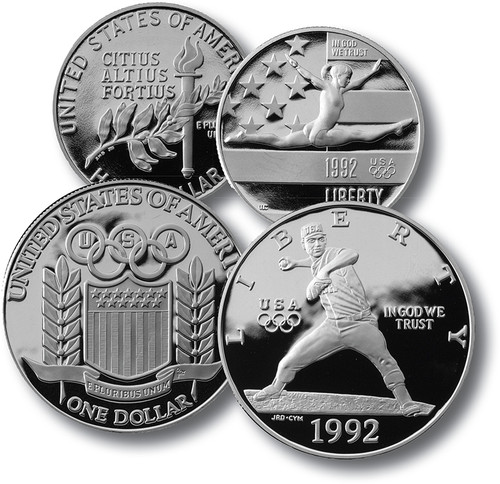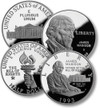
# M12073 - 1993 Bill of Rights Silver Dollar & Half Dollar, Uncirculated
Own U.S. Silver Dollar and Half Dollar Coins Honoring James Madison and the Bill of Rights
Only 1 Available!
Minted in 1993 these two uncirculated coins were produced to honor the Bill of Rights and its author (and future president) James Madison. Surcharges from the sale of these coins went to the James Madison Memorial Fellowship Trust Fund to promote graduate study of the Constitution – its history, principles, and role in our society.
The front of the half dollar coin pictures James Madison writing the Bill of Rights with his home, Montpelier, behind him. The back pictures a hand holding a torch with the inscriptions “The Bill of Rights” and “Our Basic Freedoms.” The US Mint broke with tradition and produced this coin in 90% silver. For the most part, commemorative half dollars are usually struck in a clad composition.
Interestingly, the 90% silver dollar coin makes no reference to the Bill of Rights. Instead, it pictures Madison on the front and his Virginia home, Montpelier, on the back. You’ll want to see these coins in-person to appreciate all the fine details. They’ll make great additions to your collection.
The Bill of Rights
Following the 1787 Constitutional Convention in Philadelphia, which led to the creation of the new nation’s Constitution, each state had to ratify it individually. The first nine states approved the Constitution by June 1788. Although all that was needed to approve the Constitution was nine states, four others argued it provided too much power to the central government, which could easily abuse individual rights. They believed there should be a bill of rights to prevent such abuses.
Thomas Jefferson was among the critics who advocated a “Bill of Rights” enumerating individual rights. In December 1787, Jefferson, then the ambassador to France, wrote a letter to James Madison. “A bill of rights,” Jefferson wrote, “is what the people are entitled to against every government on earth, general or particular, and what no just government should refuse, or rest on inference.”
Jefferson’s position gained strength, and a compromise was reached. Individual state legislatures ratified the document with the understanding that the first national legislative meeting under the new Constitution would pass amendments guaranteeing specific individual liberties.
James Madison was then tasked with drafting this Bill of Rights, though he initially opposed it. Madison crafted these amendments in part based on proposals he received from each state that wished to contribute. He rejected proposals calling for structural changes in the government, and kept others which created a series of amendments protecting civil rights such as free speech. Madison also drew inspiration from the Magna Carta and Virginia Declaration of Rights.
In June 1789, Madison presented nine articles with a total of 20 amendments. To his disappointment, The Senate removed several amendments and added one. On September 25, 1789, the US House and Senate met in Congress Hall to ratify twelve proposals. Once passed there, they were submitted to the states on September 28.
Then for over two years, the states voted on the articles. New Jersey was the first, ratifying 11 of the articles on November 20, 1789. They were followed by Maryland, North Carolina, South Carolina, New Hampshire, Delaware, New York, Pennsylvania, Rhode Island, Vermont, and finally Virginia. As the 11th state to ratify some or all the amendments, Virginia cemented the creation of the Bill of Rights on December 15, 1791. By the state’s votes, articles three through twelve were passed, and these became the first ten amendments, known collectively as the Bill of Rights. (The other two specified a formula for the number of seats in the House of Representatives, and restricted when changes to payment could occur for members of Congress. The second of these would later be ratified in 1992 as the 27th Amendment, more than 200 years after it was originally submitted.) Secretary of State Thomas Jefferson officially declared the ten accepted amendments as adopted on March 1, 1792.
The rights guaranteed by the amendments are freedom of speech, the press, assembly, religious worship, and to petition for redress of grievances. The right to keep and bear arms and restrictions on the quartering of soldiers in peacetime are also included. The amendments provide for protection from unreasonable search and seizure, cruel and unusual punishment, self-incrimination, and a guarantee of due process of law and a speedy public trial with an impartial jury. In addition, all powers that are not specifically given to the federal government in the Constitution are reserved for the citizenry or states. And the listing of specific rights in the Constitution does not mean that other, non-specified rights do not exist.
Own U.S. Silver Dollar and Half Dollar Coins Honoring James Madison and the Bill of Rights
Only 1 Available!
Minted in 1993 these two uncirculated coins were produced to honor the Bill of Rights and its author (and future president) James Madison. Surcharges from the sale of these coins went to the James Madison Memorial Fellowship Trust Fund to promote graduate study of the Constitution – its history, principles, and role in our society.
The front of the half dollar coin pictures James Madison writing the Bill of Rights with his home, Montpelier, behind him. The back pictures a hand holding a torch with the inscriptions “The Bill of Rights” and “Our Basic Freedoms.” The US Mint broke with tradition and produced this coin in 90% silver. For the most part, commemorative half dollars are usually struck in a clad composition.
Interestingly, the 90% silver dollar coin makes no reference to the Bill of Rights. Instead, it pictures Madison on the front and his Virginia home, Montpelier, on the back. You’ll want to see these coins in-person to appreciate all the fine details. They’ll make great additions to your collection.
The Bill of Rights
Following the 1787 Constitutional Convention in Philadelphia, which led to the creation of the new nation’s Constitution, each state had to ratify it individually. The first nine states approved the Constitution by June 1788. Although all that was needed to approve the Constitution was nine states, four others argued it provided too much power to the central government, which could easily abuse individual rights. They believed there should be a bill of rights to prevent such abuses.
Thomas Jefferson was among the critics who advocated a “Bill of Rights” enumerating individual rights. In December 1787, Jefferson, then the ambassador to France, wrote a letter to James Madison. “A bill of rights,” Jefferson wrote, “is what the people are entitled to against every government on earth, general or particular, and what no just government should refuse, or rest on inference.”
Jefferson’s position gained strength, and a compromise was reached. Individual state legislatures ratified the document with the understanding that the first national legislative meeting under the new Constitution would pass amendments guaranteeing specific individual liberties.
James Madison was then tasked with drafting this Bill of Rights, though he initially opposed it. Madison crafted these amendments in part based on proposals he received from each state that wished to contribute. He rejected proposals calling for structural changes in the government, and kept others which created a series of amendments protecting civil rights such as free speech. Madison also drew inspiration from the Magna Carta and Virginia Declaration of Rights.
In June 1789, Madison presented nine articles with a total of 20 amendments. To his disappointment, The Senate removed several amendments and added one. On September 25, 1789, the US House and Senate met in Congress Hall to ratify twelve proposals. Once passed there, they were submitted to the states on September 28.
Then for over two years, the states voted on the articles. New Jersey was the first, ratifying 11 of the articles on November 20, 1789. They were followed by Maryland, North Carolina, South Carolina, New Hampshire, Delaware, New York, Pennsylvania, Rhode Island, Vermont, and finally Virginia. As the 11th state to ratify some or all the amendments, Virginia cemented the creation of the Bill of Rights on December 15, 1791. By the state’s votes, articles three through twelve were passed, and these became the first ten amendments, known collectively as the Bill of Rights. (The other two specified a formula for the number of seats in the House of Representatives, and restricted when changes to payment could occur for members of Congress. The second of these would later be ratified in 1992 as the 27th Amendment, more than 200 years after it was originally submitted.) Secretary of State Thomas Jefferson officially declared the ten accepted amendments as adopted on March 1, 1792.
The rights guaranteed by the amendments are freedom of speech, the press, assembly, religious worship, and to petition for redress of grievances. The right to keep and bear arms and restrictions on the quartering of soldiers in peacetime are also included. The amendments provide for protection from unreasonable search and seizure, cruel and unusual punishment, self-incrimination, and a guarantee of due process of law and a speedy public trial with an impartial jury. In addition, all powers that are not specifically given to the federal government in the Constitution are reserved for the citizenry or states. And the listing of specific rights in the Constitution does not mean that other, non-specified rights do not exist.






